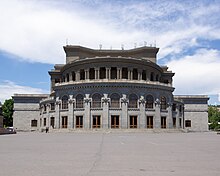
Yerevan is the capital and largest city of Armenia, as well as one of the world's oldest continuously inhabited cities. Situated along the Hrazdan River, Yerevan is the administrative, cultural, and industrial center of the country, as its primate city. It has been the capital since 1918, the fourteenth in the history of Armenia and the seventh located in or around the Ararat Plain. The city also serves as the seat of the Araratian Pontifical Diocese, which is the largest diocese of the Armenian Apostolic Church and one of the oldest dioceses in the world.

The Matenadaran, officially the Mesrop Mashtots Institute of Ancient Manuscripts, is a museum, repository of manuscripts, and a research institute in Yerevan, Armenia. It is the world's largest repository of Armenian manuscripts.
Mesrob or Mesrop is an Armenian given name.

Alexander Tamanian was a Russian-born Armenian neoclassical architect, well known for his work in the city of Yerevan.

The Armenian Genocide Memorial complex is Armenia's official memorial dedicated to the victims of the Armenian genocide, built in 1967 on the hill of Tsitsernakaberd in Yerevan. Every year on 24 April, the Armenian Genocide Remembrance Day, thousands of Armenians gather at the memorial to commemorate the victims of the genocide. The people who gather in Tsiternakaberd lay fresh flowers out of respect for all the people who died in the Armenian genocide. Over the years, from around the world, a wide range of politicians, artists, musicians, athletes, and religious figures have visited the memorial.
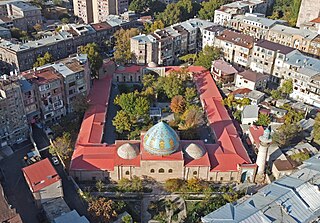
The Blue Mosque is an 18th-century Shia mosque in Yerevan, Armenia. It was commissioned by Hoseyn Ali Khan, the khan of the Iranian Erivan Khanate. It is one of the oldest extant structures in central Yerevan and the most significant structure from the city's Iranian period. It was the largest of the eight mosques of Yerevan in the 19th century and is the only active mosque in Armenia today.

Republic Square is the central town square in Yerevan, the capital of Armenia. It consists of two sections: an oval roundabout and a trapezoid-shaped section which contains a pool with musical fountains. The square is surrounded by five major buildings built in pink and yellow tuff in the neoclassical style with extensive use of Armenian motifs. This architectural ensemble includes the Government House, the History Museum and the National Gallery, Armenia Marriott Hotel and two buildings that formerly housed the ministries of Foreign Affairs and Transport and Communications. The square was originally designed by Alexander Tamanian in 1924. The construction of most of the buildings was completed by the 1950s; the last building—the National Gallery—was completed in 1977.

Arthur (Artashes) Meschian is an Armenian architect, musician, composer, poet, singer and painter. He is also known as one of the founders of Armenian rock. He was the founder and the lead singer of Apostles, the first rock band performing songs in their native language in the history of the Soviet Union. He is the author of different architectural projects, including Guest House and the new building of Matenadaran in Armenia.

Kentron, is one of the 12 districts of Yerevan, the capital of Armenia. It comprises the downtown, the commercial centre of the city. As of the 2011 census, the district has a population of 125,453.

Ghukas Chubaryan was a prominent Armenian sculptor, People's Artist of Armenia. He authored numerous works that later became symbols of the Armenian capital.

Northern Avenue is a pedestrian avenue in Yerevan, Armenia, opened in 2007. It is in the central Kentron district and links Abovyan Street with Freedom Square on Tumanyan street. It is 450 metres (1,480 ft) long and 27 metres (89 ft) wide.
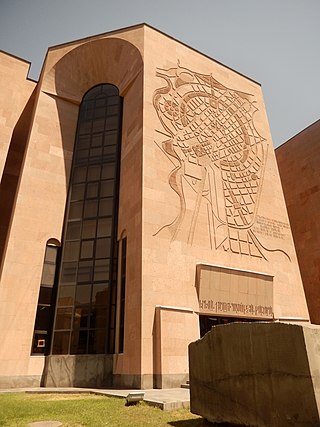
The Yerevan History Museum is the history museum of Yerevan, the capital city of Armenia. The museum was founded in 1931 as the Communal Museum. Currently, the museum is located in a building attached to the Yerevan City Hall. The architect of the building was Jim Torosyan.
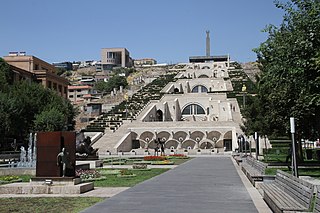
The Cascade is located in Yerevan, Armenia. White travertine stone was used for building the complex since only this stone was available in the amount sufficient for such a large-scale construction. The Yerevan’s Cascade is situated in the northern part of the city center near the Opera House and Matenadaran. The building is an architectural heritage of Soviet Armenia, it connects the city center with the Victory Park, which commemorates the Soviet Army’s victory over Nazi Germany in World War II. There is a square on the top of a hill overlooking the Ararat Valley and downtown Yerevan. The park features the Mother Armenia statue that houses a military museum dedicated to the history of World War II and the Nagorno-Karabakh conflict. The Cascade consists of 5 hillside terraces connected with 572 steps. The building is 302 m high, 50 m wide, and has a total area of 13 hectares with a 15-degree slope. The uppermost platform is called the Monumental Terrace. It houses the 40th Anniversary of Soviet Armenia monument standing 118 m tall. The terrace consists of a zone bordered by 15 columns symbolically reflecting Armenia's historical heritage. Each floor and sector of the external staircase is a unique work of art. In the inner part of the building, there are elevators and escalators connecting all platforms from the foundation to the top. The entire territory of the architectural heritage is an open-air museum of modern art lying amid the green space. It is a complex of massive stairs with fountains that rise from the Tamanyan Street pedestrian area in the central Kentron district.

Rafayel "Rafo" Israyelian was a Soviet Armenian architect.

The Armenian eternity sign or Arevakhach is an ancient Armenian national symbol and a symbol of the national identity of the Armenian people. It is one of the most common symbols in Armenian architecture, carved on khachkars and on walls of churches.
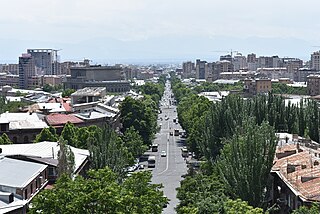
Mashtots Avenue, known as Lenin Avenue until 1990, is an avenue in the central Kentron district of Yerevan, Armenia.

Tamanyan Street is a pedestrian street in Yerevan, Armenia. It is located in the central Kentron district and links the Yerevan Cascade at the north with the Moscow street at the south. It has a length of 200 metres (660 ft) and a width of 55 metres (180 ft). It is named after the main architect of Yerevan Alexander Tamanian. Tamanian's statue stands at the entrance to the street since 1974.

Yerevan 2800th Anniversary Park, also known as the Vardanyan's park, was opened on 10 May 2019. The park is a gift from Mikayel and Karen Vardanyan on the 2800th anniversary of the foundation of Yerevan city.


